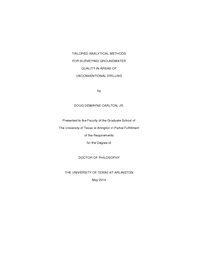
ATTENTION: The works hosted here are being migrated to a new repository that will consolidate resources, improve discoverability, and better show UTA's research impact on the global community. We will update authors as the migration progresses. Please see MavMatrix for more information.
Show simple item record
| dc.contributor.author | Carlton, Doug Dewayne, Jr. | |
| dc.date.accessioned | 2017-05-31T19:24:06Z | |
| dc.date.available | 2017-05-31T19:24:06Z | |
| dc.date.submitted | January 2014 | |
| dc.identifier.other | DISS-12640 | |
| dc.identifier.uri | http://hdl.handle.net/10106/26678 | |
| dc.description.abstract | Many questions have been raised over the environmental impact of unconventional drilling techniques, especially on the groundwater of the extraction area. Analytical approaches and methods specific to hydraulic fracturing had to be developed due to the lack of available research at the time. The analytical approaches chosen for the extensive survey of groundwater quality included general groundwater measurements, bulk water characterization, and organic, inorganic, and ionic speciation. Some of the chosen targets included volatile and semivolatile ingredients in hydraulic fracturing fluid, metals associated with drilling fluids or formation waters, and total carbon and nitrogen measurements. These methods were developed and then implemented in studies to understand the effect unconventional drilling techniques have on the groundwater in the Barnett Shale region of north Texas and the Cline Shale formation of west Texas. Measured constituents were correlated to distance to the nearest gas well, databased information before unconventional drilling occurrences, and changes over time in the Cline Shale. Groundwater for the regions was collected through private residential water wells. Interpretations of the findings herein have resulted in a few conclusions regarding unconventional drilling in two regions of Texas. First, it was concluded that the Barnett Shale seems to be victim to subsurface perturbations giving rise to sporadic elevated arsenic, strontium, selenium, and total dissolved solids as compared to the decade of the 1990s, a time before widespread unconventional drilling in the area. Second of all, heavy metal concentrations were highest in areas closest to natural gas wells and in more shallow wells. The third conclusion, resulting from a time-lapse study located within the Cline Shale, was variable lifetimes are present for fluctuating groundwater parameters, bulk water measurements, and endogenous organic compounds. Also found within these pages is a fundamental study quantifying the amount of matrix effect present in elemental analysis of 19 metals for selected groundwater samples across the Barnett Shale region. Reversed phase - solid phase extraction was used to separate hydrophobic constituents from the samples to assess the influence toward observed matrix effects of the ionic and hydrophobic portions of the water. General water quality parameters like total dissolved solids and salinity were also considered. Discussion is presented toward suggested sample preparation depending on the analyte of interest. Lastly, presented is a biological assay, QwikLite<sup>TM</sup> 200, which would be suitable for rapid response field analysis of chemical spills related to unconventional drilling. The assay was capable of accurately responding to glutaraldehyde and hydrochloric acid, two common constituents in fluid mixtures of unconventional drilling, in as little as 4 hours. The assay demonstrates similar or greater sensitivity than other bioassays for these two compounds and a quicker response time. | |
| dc.description.sponsorship | Schug, Kevin A. | |
| dc.language.iso | en | |
| dc.publisher | Chemistry & Biochemistry | |
| dc.title | Tailored Analytical Methods For Surveying Groundwater Quality In Areas Of Unconventional Drilling | |
| dc.type | Ph.D. | |
| dc.contributor.committeeChair | Schug, Kevin A. | |
| dc.degree.department | Chemistry & Biochemistry | |
| dc.degree.discipline | Chemistry & Biochemistry | |
| dc.degree.grantor | University of Texas at Arlington | |
| dc.degree.level | doctoral | |
| dc.degree.name | Ph.D. | |
Files in this item
- Name:
- Carlton_uta_2502D_12640.pdf
- Size:
- 4.321Mb
- Format:
- PDF
This item appears in the following Collection(s)
Show simple item record


